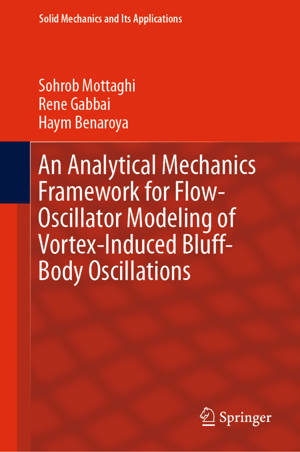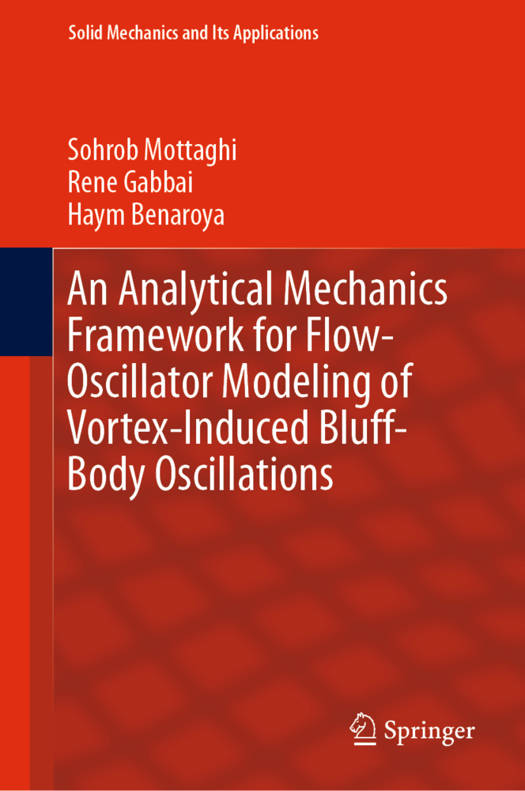
- Afhalen na 1 uur in een winkel met voorraad
- Gratis thuislevering in België vanaf € 30
- Ruim aanbod met 7 miljoen producten
- Afhalen na 1 uur in een winkel met voorraad
- Gratis thuislevering in België vanaf € 30
- Ruim aanbod met 7 miljoen producten
Zoeken
An Analytical Mechanics Framework for Flow-Oscillator Modeling of Vortex-Induced Bluff-Body Oscillations
Sohrob Mottaghi, Rene Gabbai, Haym Benaroya
€ 167,95
+ 335 punten
Omschrijving
This self-contained book provides an introduction to the flow-oscillator modeling of vortex-induced bluff-body oscillations. One of the great challenges in engineering science also happens to be one of engineering design - the modeling, analysis and design of vibrating structures driven by fluid motion.
The literature on fluid-structure interaction is vast, and it can be said to comprise a large fraction of all papers published in the mechanical sciences. This book focuses on the vortex-induced oscillations of an immersed body, since, although the importance of the subject has long been known, it is only during the past fifty years that there have been concerted efforts to analytically model the general behavior of the coupling between vortex shedding and structural oscillations. At the same time, experimentalists have been gathering data on such interactions in order to help define the various regimes of behavior. This data is critical to our understanding and to those who develop analytical models, as can be seen in this book. The fundamental bases for the modeling developed in this book are the variational principles of analytical dynamics, in particular Hamilton's principle and Jourdain's principle, considered great intellectual achievements on par with Newton's laws of motion. Variational principles have been applied in numerous disciplines, including dynamics, optics and quantum mechanics. Here, we apply variational principles to the development of a framework for the modeling of flow-oscillator models of vortex-induced oscillations.
The literature on fluid-structure interaction is vast, and it can be said to comprise a large fraction of all papers published in the mechanical sciences. This book focuses on the vortex-induced oscillations of an immersed body, since, although the importance of the subject has long been known, it is only during the past fifty years that there have been concerted efforts to analytically model the general behavior of the coupling between vortex shedding and structural oscillations. At the same time, experimentalists have been gathering data on such interactions in order to help define the various regimes of behavior. This data is critical to our understanding and to those who develop analytical models, as can be seen in this book. The fundamental bases for the modeling developed in this book are the variational principles of analytical dynamics, in particular Hamilton's principle and Jourdain's principle, considered great intellectual achievements on par with Newton's laws of motion. Variational principles have been applied in numerous disciplines, including dynamics, optics and quantum mechanics. Here, we apply variational principles to the development of a framework for the modeling of flow-oscillator models of vortex-induced oscillations.
Specificaties
Betrokkenen
- Auteur(s):
- Uitgeverij:
Inhoud
- Aantal bladzijden:
- 245
- Taal:
- Engels
- Reeks:
- Reeksnummer:
- nr. 260
Eigenschappen
- Productcode (EAN):
- 9783030261313
- Verschijningsdatum:
- 22/08/2019
- Uitvoering:
- Hardcover
- Formaat:
- Genaaid
- Afmetingen:
- 156 mm x 234 mm
- Gewicht:
- 539 g

Alleen bij Standaard Boekhandel
+ 335 punten op je klantenkaart van Standaard Boekhandel
Beoordelingen
We publiceren alleen reviews die voldoen aan de voorwaarden voor reviews. Bekijk onze voorwaarden voor reviews.








